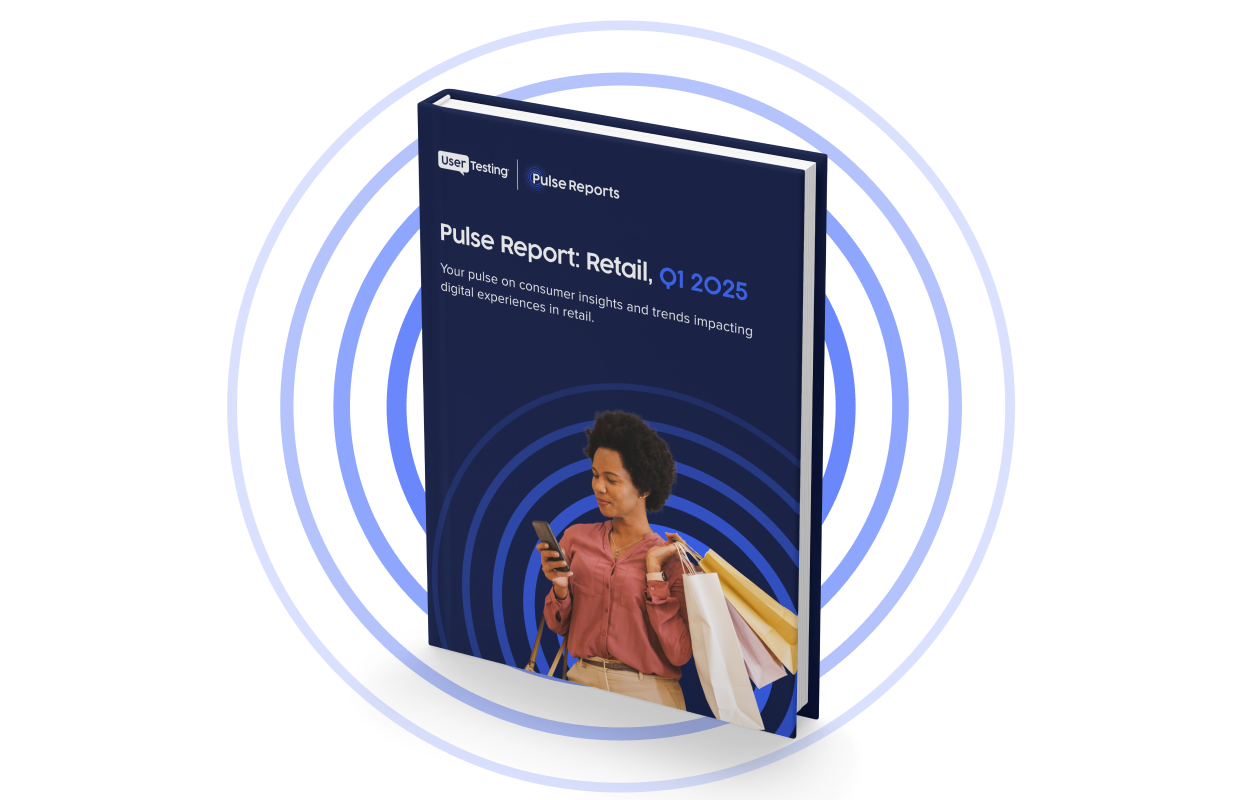
13 Powerful customer retention strategies

Effective customer retention strategies can make or break the success of enterprises. While acquiring new customers has its place, the most successful organizations understand that their growth hinges on keeping existing customers happy and loyal for the long haul via customer retention strategies.
When an organization loses a customer, it loses more than a single sale; it's deprived of the lifetime value of that customer relationship.
Because of rising marketing expenses, acquiring new customers is more expensive than retaining existing ones. According to GetApp, 44% of marketers anticipate a 5% to 25% increase in budgets to address rising customer acquisition costs, driven by the need for new digital tracking methods.
Marketing insights
Discover how UserTesting helps marketers refine messaging, optimize campaigns, and drive stronger customer connections.
The message is clear: Customer retention strategies must be a priority for organizations seeking sustainable profitability and market dominance. This definitive guide explores the critical importance of retention, essential metrics to track it, and 13 practical strategies to help organizations lock in customer loyalty for good.
Organizations can tap into huge growth potential with the right customer retention strategy.
What is customer retention?
Customer retention refers to an organization's ability to retain its existing customers over time. It's essential to a successful strategy, as retaining existing customers is more cost-effective than getting new ones. It helps organizations build a base of loyal customers who continue to purchase their products or services and recommend them to others.
"...Digital brands do need to invest in rapidly scaling their user base, but helping customers fall in love with your product and building loyalty through non-intrusive and value-adding engagement is a whole different ball game." - Rahul Mirchandani, SVP of Product & Revenue, Dream11
The need for customer retention strategies
There are several vital reasons why focusing on customer retention is critical:
- Keeping your existing customers is more cost-effective than acquiring new ones. Retaining customers is cost-effective thanks to nurturing established relationships, which means lower marketing expenses.
- Loyal customers tend to spend more over time. As the relationship strengthens, repeat customers buy more products and services. It thus increases customer lifetime value.
- Customer retention boosts referrals and word-of-mouth marketing. Satisfied, loyal customers serve as brand advocates, referring friends, family, and social connections.
- High retention rates support sustainable long-term growth. Organizations with higher retention enjoy stable revenue streams and are better equipped to handle temporary dips in new sales.
- Losing customers means losing their future value. The lifetime value of a lost customer also includes the value of their potential future transactions and referrals.
For long-term success, organizations should prioritize retaining happy and engaged customers. Maintaining relationships with existing customers brings in steady revenue, boosts profits, and strengthens brand loyalty.
Key customer retention metrics
Monitoring and measuring key performance indicators (KPIs) to gauge effectiveness is critical when developing a customer retention strategy. Core metrics to track include:
- Customer retention rate (CRR): The percentage of customers retained over a period.
- Customer churn rate (CCR): The rate at which customers discontinue transactions or deactivate their accounts during a given period.
- Customer lifetime value (CLV): The total revenue a customer contributes during their entire relationship with an organization. It helps quantify the loss when churn occurs. Higher CLV means greater incentive to retain.
- Net promoter score (NPS): A customer satisfaction and loyalty metric that measures the willingness of customers to recommend a brand to others.
Monitoring these KPIs makes it easier for organizations to make data-backed decisions regarding the value and direction of their customer retention strategies.
13 excellent customer retention strategies
There are many creative and effective ways to improve how organizations retain and engage customers for the long haul. Here are 13 customer retention strategies to consider:
1. Conduct user research and usability testing
One powerful way to increase customer retention is by directly gathering user insights. Practices like user research and usability testing put the customer's perspective front and center. User research aims to understand user behaviors, needs, motivations, and pain points regarding particular products and services. It helps uncover opportunities to remove friction and improve customer experiences.
Usability testing observes actual users completing tasks and objectives. It reveals usability issues that may cause customers confusion, difficulty, or frustration.
Experience research solutions like UserTesting provide organizations on-demand access to suitable research participants. It makes conducting user experience research scalable, fast, and cost-effective. By listening directly to the voice of the customer, an organization gains human insight to drive retention and loyalty. Their feedback helps fix pain points, exceed expectations consistently, and offer personalized, positive experiences.
"[W]hen a company makes a commitment to acting on customer insights and investment in user research, over time, what we do is we increase the probability of our success.” - Eric Mahlstedt, Head of User Research for Cloud, Data, and AI business units, IBM
2. Improve user interface and user experience
Flawless, frictionless customer experiences build brand affinity and retention. Two key elements influencing the quality of experience are a product's user interface (UI) and overall user experience (UX).
The UI refers to the visual design and interactive elements enabling customers to complete tasks. UI fixes may involve updates like:
- Improved information architecture and navigation
- More intuitive placements of buttons and icons
- Better error message feedback
Meanwhile, UX examines more holistic interactions across the entire customer journey. Techniques like user flows and journey mapping help identify pain points and moments of delight. Improving holistic UX may involve changes like:
- Personalization features
- Frictionless account registration
- Enjoyable onboarding tutorial
- Seamless navigation across devices
Regular usability testing provides the customer feedback needed to iterate and enhance UI and UX. It directly strengthens retention by reducing friction and confusion. Customers stay loyal to brands delivering seamless, pleasing experiences across touchpoints.
3. Create personalized customer experiences
Personalization tailors interactions based on individual user data, behavior, preferences, and context. The ideal experience adapts dynamically to each customer.
Implementing personalization has proven to boost key retention KPIs like:
- Increased repeat purchase rates
- Longer customer lifetime value
- Higher product usage and engagement
- Reduced churn
Strategies for better personalization include:
- Individualized product recommendations
- Customized onboarding
- Segmented content and messaging
- Predictive intent analysis
Testing personalization ideas with actual target users ensures the delivery of relevant, enjoyable experiences. This cements loyalty by making customers feel valued and appreciated.
"The way our customers operate their businesses and live their lives in today's interactive digital world requires a shift to a hyper-personalized experience. Customers expect us to know them as individuals and provide them with access to more information and visibility." - Laurie Tucker, SVP of Corporate Marketing, FedEx
4. Improve customer support and service
Providing stellar customer support is another critical factor for retention. Every support interaction either strengthens or weakens the customer relationship. Teams must analyze customer satisfaction scores (CSAT), wait times, and resolution rates to identify areas for improvement. Common retention-boosting support tactics include:
- Live chat for instant, personalized assistance
- Expanded FAQs and self-help content
- Automated interactions via chatbots
- Multi-channel support (email, phone, social, etc)
- Proactive checking in on customers
- Feedback collection mechanisms
Support teams must always have customer context and data at their fingertips, enabling personalized, empathetic service. Teams can use session replay tools to observe customer support interactions. This reveals pain points and opportunities from the user's point of view and provides insight to optimize processes, tools, behaviors, and knowledge that close experience gaps.
"The goal as a company is to have customer service that is not just the best but legendary." - Sam Walton, Founder of Walmart
5. Offer frequent communication and updates
Brands retaining customers for life foster lasting connections through continuous engagement. An onboarding sequence or transactional email is just the start. It's essential to keep communicating value long after sign-up.
Relevant, high-signal updates show customers that the organization provides enduring value beyond the initial purchase. For example, for a software as a service (SaaS) organization, this may include:
- Product update emails
- Educational blog content
- Newsletter with tips and tricks
- New feature announcements
- Retention-focused promotions
However, it's better to avoid overly sales-focused outreach. Instead, a better approach would be to craft messages focused on helping users succeed with the target product or services. This customer-centric approach earns attention and trust through valuable information and support.
It's also a great move always to test outreach content and messaging with existing user research panels via platforms like UserTesting. Optimizing based on customer feedback helps ensure communications land as intended across subscriber segments. Moreover, an intelligent strategy continuously measures engagement and open rates before a full-scale launch.
Frequent and helpful communications that put the customer first demonstrate a genuine commitment to the relationship and consistently delight retained users over time.
6. Build and maintain strong relationships
Retention stems from mutual understanding and shared benefit between the brand and the consumer. It involves demonstrating to customers that the organization genuinely cares about their needs and satisfaction.
Tactics that cultivate trust and connections include:
- Onboarding interviews or personal introductions
- Proactive check-ins via email or in-product surveys
- Special events, user conferences, and local meetups
- Loyalty rewards and VIP access
- Behind-the-scenes content
Interactions should emphasize listening first and understanding each customer's unique situation deeply. Such care earns ambassador-level loyalty even through ups and downs.
Connecting support agents with specific account managers is a great way to make inquiries feel like friendly conversations. Occasionally, relationship managers call key users directly to discuss feedback and feature requests, adding a personal touch. Treating customers as true partners beyond transactions strengthens the bond, making them less susceptible to external temptations or passing gimmicks from competitors.
7. Implement referral programs
Referral programs incentivize existing customers to promote the brand they love. These are powerful acquisition channels proven to drive higher conversion rates and lower cost per acquisition (CPA).
However, beyond new customer acquisition, referrals are a vital retention lever because referring a friend or peer puts social reputation on the line. When someone refers others to a brand, they signal:
- Satisfaction: They find a product valuable enough to recommend
- Belief: They believe their connections will have a similarly positive experience
After all, any disappointment reflects poorly on the advocate who made the referral initially. To leverage this built-in social pressure, optimize referral program design elements like:
- Offers: Free trials, discounts, or account credits
- Channel integration: Email, web, and social referral options
- Triggers: Automatic and integrated into natural user flows
- Gamification: Compelling prizes, tiers, and leaderboards
When done well, referral programs incentivize the brand's best promoters to stick around. It also generates ideal new users for the enterprise through word of mouth.
8. Exceed customer expectations
Consumer expectations rise constantly. What delights today becomes expected over time. Savvy brands get ahead of this curve to retain customers.
To achieve this, teams can start by quantifying customer expectations in crucial areas such as support resolution time, feature releases, or shipping speed. They can do so through surveys and NPS feedback as a baseline.
For a more proactive approach, organizations can engage user research panels and focus groups during early development stages to craft high-value deliverables. For instance, if customers expect a two-business-day shipping timeframe, teams can test the response to overnight delivery capabilities before fully implementing the change.
Managing the messaging carefully is essential when introducing new features that genuinely impress customers. A successful strategy involves underselling and then overdelivering to make these pleasant surprises more impactful. Conduct user interviews to determine how customers feel about a new offer and how it’s being communicated.
Getting this formula right earns attention, word-of-mouth interest, and retention momentum, even without costly incentives.
"The customer changes every day, so we need to remain keenly interested in the customer and evolve to remain relevant." - Mike Motz, President, Shoppers Drug Mart
9. Utilize social media for engagement
Social media presents a significant touchpoint for ongoing branded engagements and conversations. However, integrating retention elements into social media customer service, content strategy, and community building is vital.
It is a good practice to directly address customer complaints and negative feedback on social media with care and concern. When issues pop up, responding in a friendly and attentive way reassures customers that the organization hears them and is committed to making things right.
In addition, sharing valuable content that goes beyond transactions and resonates with specific audiences is a smart move. For example, a wedding planning service might share marriage advice, vendor tips, and newlywed encouragement on its social media channels.
Also, building a social following and community around the brand using relevant hashtags, user-generated content, and polls centered on shared interests helps create a sense of connection. All these efforts demonstrate a genuine commitment to relationships and increase retention by building affinity. However, it's equally important to keep an eye on perceptions and listen to social conversations continuously to enhance efforts over time.
Test social media campaigns with customers and target audiences to ensure they resonate before you launch.
10. Implement a customer loyalty program
Customer loyalty programs provide incentives and perks for repeat purchases and ongoing engagement. Rather than a short-term gimmick, an enduring loyalty strategy retains the best customers on solid footing. Effective programs include elements like:
- Tiers with customized rewards
- Early access to new products or features
- Free shipping, discounts, or exclusive content
- VIP customer support and concierge service
- Special status, badges, and pampering
The psychological appeal of insider treatment makes customers feel valued. When done right, loyalty programs increase retention metrics like order frequency and customer lifetime value amongst enrolled members.
Teams can leverage tools like UserTesting to test loyalty program concepts rapidly before full rollout. Optimizing the offering, messaging, and overall UX based on user feedback leads to maximum enrollment and retention boosts.
11. Leverage customer success stories
When an organization aims to foster trust and peer endorsement, it can leverage customer success stories. Seeing existing customers' actual results and experiences provides powerful social proof for new users. Such customer testimonials bring claims to life within an authentic context.
Sharing the journeys of retained customers also motivates users who personally connect with featured stories. This transparency helps customers envision the total value possible as they invest in mastering the product over the long haul.
To gather credible stories, teams can conduct surveys and interviews asking customers about their experience and key milestones achieved. Encouraging customers to provide examples, quantify results, and share their success in their specific use case adds vivid and genuine content that persuades through narrative detail.
12. Collect and act on customer feedback
The voice of the customer provides the core insights needed to drive retention improvements over time. Studies find that 96% of unhappy customers don't complain directly about poor experiences. 91% of those will leave and never come back.
That's why actively collecting customer feedback across channels remains vital for any retention strategy. Customers want to feel heard by the organizations they patronize. User research, surveys, reviews, and other mechanisms for gathering customer input provide the voice of the customer to guide efforts.
However, just collecting customer feedback is simply not enough. Organizations need to demonstrate that they act on the insights received. Without evidence that feedback is driving meaningful change, customers will disengage.
It's thus equally critical to inform customers when their input has directly shaped decisions around product enhancements or service improvements. Transparently showing how the organization has listened empowers users and deepens engagement. Strategic customer communication highlighting that product updates or policy changes came directly from user feedback increases the perception that the organization values the voice of its customers.
13. Continuously measure and improve customer retention
Finally, ongoing measurement enables organizations to track the effectiveness of customer retention programs, spot potential issues early, and make data-driven decisions on improvements.
Key metrics to monitor include customer lifetime value, churn rate, repeat purchase rate, customer satisfaction scores, and net promoter scores. Solutions like UserTesting allow you to dig further into existing metrics to discover why customers feel the way they do.
As metrics are analyzed, organizations should identify the root causes behind churn and dissatisfaction. UserTesting provides key insights to uncover the emotional, behavioral, and contextual drivers behind these metrics—these human insights direct organizations towards targeted solutions that have maximum impact.
Continual minor tweaks and testing based on these data points fuel steady gains in retention and loyalty.

Pulse Report: Retail, Q1 2025
Uncover the drivers behind consumer loyalty and how innovative retailers succeed in this quarterly Pulse Report.





